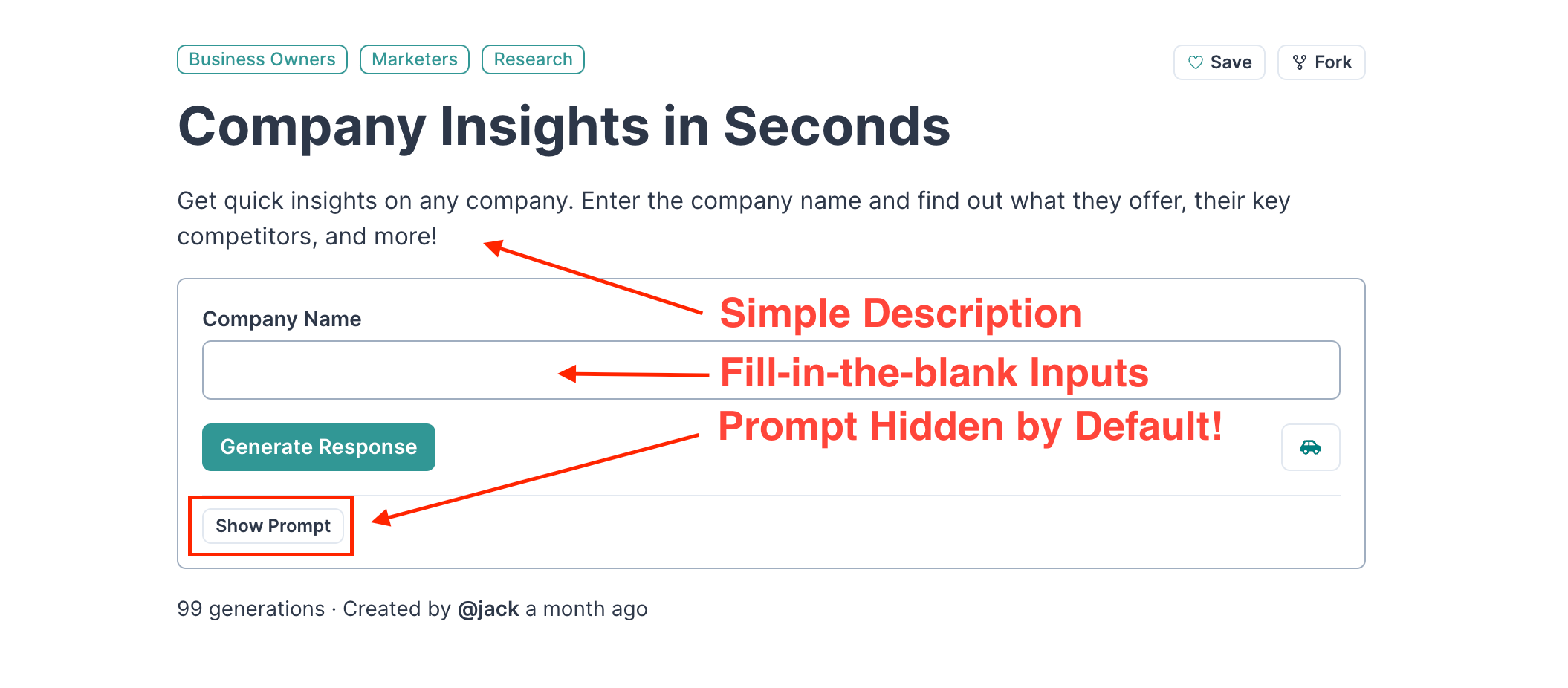Hide Your Prompt: A Better UX for Sharing Simple AI Tools
by Jack O'Brien on Jun 22nd, 2023

Using ChatGPT effectively is an acquired skill. Without prior experience and learned intuition, your AI generated responses will probably be improperly formatted, way too long, a bit cold in tone, or simply not what you were hoping for.
I have a good deal of experience working with opaque software systems, so I was lucky to pick up the basics of AI prompting fairly quickly (though I’m still far from an expert prompter). You need to be extremely specific. You need to be concise. You need to explain your thought process and your desired output. Lots of people have said that AI prompting today is like learning how to use Google in 2001, and I think there’s truth to that idea. We’re still learning how to correctly poke the machine.
Sharing AI Knowledge Today
Over 100 million people have used ChatGPT, and I’m fairly certain the vast majority of them don’t know how to use it to the best of its ability (enter 1000+ Twitter threads and LinkedIn posts on how “you’re not using ChatGPT correctly”). AI chatbots open up infinite possibilities to explore virtually all documented human knowledge and experience, but a small uninteresting subset of that potential is what most people see today.

Ok just opening up this ChatGPT thing everyone's talking about and... what do I do now?
The solution to this nascent problem of “how to use the everything intelligence machine” has been prompt sharing. Social media accounts, newsletters, and websites aggregate great prompts and post them for you to copy. For example, here’s a prompt from Aaditsh who created neatprompts.com.
Give me 5 Twitter post ideas to drive interest in [topic]. Keep the ideas engaging and informative.
Topic = [Insert Here]
This sharing solution works great to a point. You have a problem, you find the right prompt to help you solve it, copy the prompt, paste it into ChatGPT, replace the relevant parts of the prompt, and finally you’ve got superpowers. There’s friction in that process of searching and copying, but it’s the best way to get more out of ChatGPT today as a novice AI user.
I think there’s enough room to improve that friction to merit a new UX.
Easier Discovery, Less Friction
Users should be able to discover a “prompt”, use it immediately, and flexibly decide what to do with the output. They should be able to improve the prompt, share it, and continue to build on the best ways to pry out value from these powerful AI systems.
A UX with simpler prompt discovery and frictionless use blows the doors open for both AI novices and prompt engineers. AI novices, previously deterred by mediocre AI results and friction in prompt discovery/copying, see the true value in generative AI. Productivity, accuracy, and happiness increases in their work as they adopt these AI tools. Prompt engineers, now with a frictionless way to share their well designed prompts, become more obviously useful as freelancers and full time employees at organizations. All organizations will improve themselves with these AI tools or get left behind in the near future (dun dun DUN!).
Hide the Prompt
Users don’t really care about the prompt, they care about the value generated from the prompt. Signaling that value is much more important during the discovery and use of a prompt than understanding the underlying template. I think a better AI UX is to hide the prompt altogether.
A simple “AI Tool” now consists of more than just a prompt. It’s the prompt + metadata. Metadata can include a title, a description, inputs for the prompt if it’s a template, and info about those inputs. AI users, especially novices, can now search and use prompts fully based on their titles and descriptions. The value is conveyed up front, without the need to learn to read or write prompts.
As a prompt engineer, there’s pros and cons. For one, you have more work on your plate to write differentiating metadata, but the benefits vastly outweigh the additional tasks. On the prompting writing side, you can share extremely elaborate and dense prompts with an easy to understand title and description. For example, you can write three paragraphs of instructions or embed an entire document of guidelines into the prompt itself: the user never has to see it. You're free to go nuts.
This UX delivers maximum value to the user, and unlocks infinite potential for prompt engineers to experiment and ship their best work regardless of complexity.
LowTech AI is built on the vision of this simple UX to discover, use, create, fork, and share AI tools. We're pairing the best prompts with the most powerful AI models on top of the simplest UX imaginable. We’re pumped to continue exploring how to improve the experience for AI users and prompt engineers.
P.S. If you’ve never used LowTech AI, checkout a simple tool here! Want to improve it? Fork it!